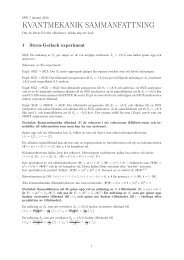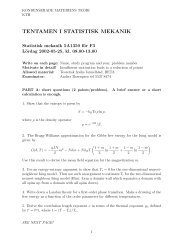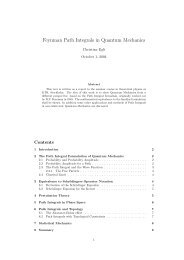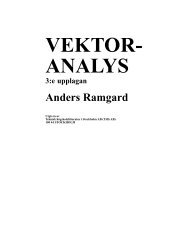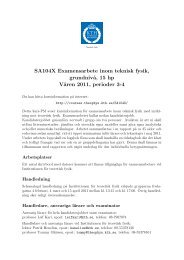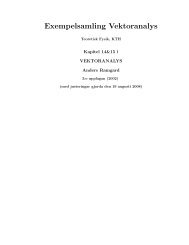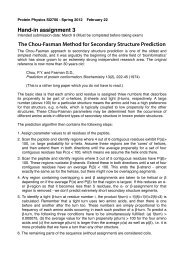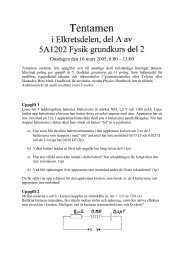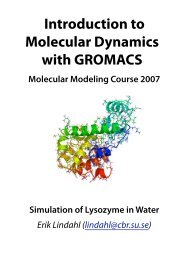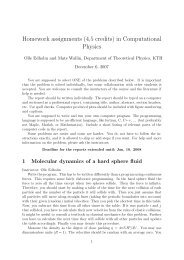[VAR]=Notes on variational calculus
[VAR]=Notes on variational calculus
[VAR]=Notes on variational calculus
You also want an ePaper? Increase the reach of your titles
YUMPU automatically turns print PDFs into web optimized ePapers that Google loves.
As above <strong>on</strong>e can make precise this c<strong>on</strong>diti<strong>on</strong> <strong>on</strong> u by<br />
d<br />
dε J[u + εη] ∣<br />
∣∣∣ε=0<br />
= 0 (26)<br />
for all functi<strong>on</strong>s η = η(x, y) <strong>on</strong> Ω. The following computati<strong>on</strong> similar to the <strong>on</strong>e in<br />
(11),<br />
∣<br />
d ∣∣∣ε=0<br />
dε J[u + εη]<br />
= d ∫<br />
F(u(x, y) + εη(x, y), u x (x, y) + εη x (x, y), u y (x, y) + εη y (x, y), x, y)dxdy<br />
dε Ω<br />
∫ ( ∂F<br />
∂F<br />
= η(x, y) +<br />
Ω ∂u(x, y) ∂u x (x, y) η x(x, y) + ∂F )<br />
∂u<br />
} {{ }<br />
y (x, y) η y(x, y) dxdy<br />
} {{ }<br />
d<br />
dx ( ∂F<br />
∂ux(x,y) η(x,y))−η(x,y) d ∂F<br />
···<br />
dx ∂ux(x,y)<br />
∫ ( ∂F<br />
= BT + η(x, y)<br />
∂u(x, y) − d ∂F<br />
dx ∂u x (x, y) − d ∂F<br />
)<br />
dxdy (27)<br />
dy ∂u y (x, y)<br />
Ω<br />
where<br />
∫<br />
BT =<br />
Ω<br />
( d<br />
dx ( ∂F d<br />
η(x, y)) +<br />
∂u x (x, y) dy ( ∂F<br />
)<br />
∂u y (x, y) η(x, y)) dxdy<br />
∮ (<br />
∂F<br />
∂F<br />
)<br />
= η(x, y)dy −<br />
∂u x (x, y) ∂u y (x, y) η(x, y)dx<br />
∂Ω<br />
(28)<br />
is a boundary term (we used Green’s theorem) which vanishes since u is fixed <strong>on</strong> ∂Ω,<br />
and thus the allowed variati<strong>on</strong> functi<strong>on</strong>s η vanish <strong>on</strong> ∂Ω. We thus can c<strong>on</strong>clude, as<br />
above:<br />
Fact E: All soluti<strong>on</strong>s of the Problem E above satisfy the following Euler-Lagrange<br />
equati<strong>on</strong>s<br />
∂F<br />
∂u(x, y) − d ∂F<br />
dx ∂u x (x, y) − d ∂F<br />
dy ∂u y (x, y) = 0 (29)<br />
where u| ∂Ω is fixed.<br />
Again, it is imporant to distinguish partial and total derivatives, e.g.,<br />
d ∂F<br />
= ∂2 F<br />
u x + ∂2 F<br />
u xx +<br />
∂2 F<br />
u xy + ∂2 F<br />
dx ∂u x ∂u∂u x ∂u y ∂u x ∂x∂u x<br />
∂u 2 x<br />
(we suppress arguments x, y of u and its derivatives) etc.<br />
Similarly as above there are also modified variati<strong>on</strong>al problems where u is allowed<br />
to vary <strong>on</strong> all of ∂Ω or <strong>on</strong> parts of it. In this case <strong>on</strong>e also gets the Euler-Lagrange<br />
12


![[VAR]=Notes on variational calculus](https://img.yumpu.com/35639168/12/500x640/varnotes-on-variational-calculus.jpg)
